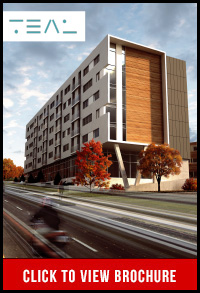From room to region
By Anna Guy
Founded by Tom Emodi and Caroline Caskey, TEAL Architects+Planners has a vision to marry architecture and municipal planning.
 Halifax – based TEAL Architects + Planners has a mandate for innovation, design, collaboration and value. The group has purposefully remained small, and is structured so that the mostly young team can develop into early positions of ownership, responsibility, and authority. “Our aim is for the team to own the firm as soon as possible,” says Emodi.
Halifax – based TEAL Architects + Planners has a mandate for innovation, design, collaboration and value. The group has purposefully remained small, and is structured so that the mostly young team can develop into early positions of ownership, responsibility, and authority. “Our aim is for the team to own the firm as soon as possible,” says Emodi.
Based in Halifax, TEAL’s team is currently eight people strong, with the ninth team member being the client and/or consultant. The team works collaboratively with clients and integrated consulting teams to determine their social priorities, and takes inspiration from a wealth of sources, including environmental studies, landscape design, human health, mathematics, sculpture, building construction and cabinetry.
“We try to address what we consider a challenge in the education of the majority of planners,” says Emodi, “and possibly in the education of architects. In most planning programs there is minimal visual education about the history and theory of how urban spaces are made by buildings, and how dimensions work to enable people to live, work, play and gather to enjoy urban spaces.” In response, TEAL’s team tries to integrate planning, urban design and architecture.
Emodi is uniquely qualified to speak on this. Between 1983 and 2004 he was a Professor in Architecture at The Technical University of Nova Scotia and Dalhousie University, and served over 6 years as Dalhousie’s Founding Dean of Architecture and Planning (1997-2003), and currently he serves as the Chair of Ryerson University’s Programme Advisory Committee for the Department of Architectural Science.
Incorporating architectural principles to the design of urban spaces is a focus at TEAL, in conjunction a focus on sustainability in the environment, finance, culture and production. “We work from room to region,” says Emodi. “We work at a small scale with interiors all the way to regional scale with planning work. Our aim is to make the biggest impact with smallest moves.”
TEAL’s influence is felt mostly in Nova Scotia and Newfoundland, but has earned national and international accolades for a variety of projects—most recently in Archdaily.com (the world’s most visited architecture website) for its work on Webster Terrace, a distinguished modern movement house in Halifax. A commonality among all projects is a deep understanding of the working environment, ergonomics, and the function of the space. “We need to ensure comfortable and workable dimensions,” says Emodi.
TEAL frequently wrestles with how architectural dimensions integrate with urban dimensions. “Often when urban and subdivision policies, rules or layouts are developed without architectural knowledge, the dimensions don’t work for buildings,” says Emodi. “When three dimensional urban rules are decided by people who haven’t done any internal planning, it is difficult to fit sensible, well designed buildings.”
TEAL’s planning work recently won “Best Comprehensive Plan” from the Atlantic Planners Institute for the 2016 Planning Excellence Awards, specifically recognizing the South Shore Housing Action Coalition Housing Needs Assessment.
A New Wave
The TEAL team continues to push the envelope with innovate material choices. They are preparing to build the first six-storey wood mixed-use building in Atlantic Canada. TEAL was awarded the Atlantic Wood Design award in recognition of “advancing the use of wood in all types of construction through design excellence, advocacy, and innovation.”
Jury member, David Moses of Moses Structural Engineers says, “This second year of the Wood Design Awards exemplifies the emerging trend of using local, sustainable wood in construction and I have no doubt this is just the beginning of a movement throughout Atlantic Canada to expand the innovative and creative use of wood in design.”
With the support of innovative clientele, a changing regulatory environment, and vision, TEAL is on the forefront of a new wave of buildings made with wood frames. “Wood is attractive because it is a renewable resource, and incredibly strong when used well,” says Emodi, who points to the renaissance of wood-framed buildings in most of Europe, and a new trend towards wood in B.C. “We are also dedicated to increasing awareness and excitement concerning the new building code changes to further enable wood design,” says Emodi.
An active member and sustainability ally of the Ecology Action Centre, a partner with the Credit Union Atlantic (CUA) and the Dalhousie Transportation Collaboratory, TEAL values giving back to the industry. From small spaces to outside-the-box, TEAL gives each project and client dedication, passion, and a fresh perspective.
For more information, please visit www.tealarchitects.com






